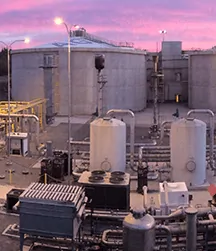

Under section 211 of the Clean Air Act, the Environmental Protection Agency (EPA) is required to set renewable fuel percentage standards every year, including for cellulosic biofuel, biomass-based diesel, advanced biofuel, and total renewable fuel. In November the EPA established the 2017 standards, which will apply to all motor vehicle gasoline and diesel produced or imported in the year 2017. Most biogas produced qualifies as Advanced Cellulosic Biofuels, or the D3 category, which is the same as cellulosic (non-corn) ethanol. For the last several years, nearly 95% of the advanced cellulosic fuel generated has been from digester and landfill biogas, not cellulosic ethanol.
The final rule also establishes the four percentage standards applicable to producers and importers of gasoline and diesel, based on volume requirements. Renewable Fuel Volumetric Obligations (RVOs) are expected to continue driving the market to overcome constraints in the renewable fuel distribution infrastructure. This, in turn, could lead to substantial growth over time in the production and use of renewable fuels. If a renewable fuel-producing project uses a Renewable Fuel Standard (RFS)-approved pathway and is registered with EPA, the project can generate credits that can be sold to produce additional revenue. The value of these Renewable Identification Numbers (RINs) credits fluctuates based on market supply and demand.
The 2017 RVOs finalized in November for 2017 will help drive the market demand for these credits. Producers of biogas want the demand for RVO to be higher than the supply of biogas that will actually be produced and used as vehicle fuel during the year. This will protect the value of RINs, encouraging revenues for biogas-vehicle fuel projects and financing for new projects. Digester and landfill biogas normally have the highest value of all RINs.
Overall, EPA’s 2017 standards recognize the important role that biogas plays among all advanced biofuel producers, including cellulosic ethanol, and the role biogas will continue to play for generating renewable fuel for US vehicles.
SCS Engineers’ National Experts are available to answer your questions about the impact of the 2017 standards on your business and current and potential projects. Click here to contact SCS.

SCS Energy, a division of SCS Engineers, supported the design | build | operation and maintenance of a new Metrogas high-Btu gas plant located at La Farfana Wastewater
Treatment Plant near Santiago, Chile. La Farfana is owned by Aguas Andinas. Metrogas, the chief natural gas distribution company in Chile, launched commercial operation of their new digester gas to high-Btu gas plant in April, 2015. The plant processes 2,200 scfm (3.17 mmscfd) of raw digester gas, producing 1,238 scfm (1.78 mmscfd) of pipeline quality product gas.
Two different clean-up technologies, membrane and pressure swing adsorption, were considered during the feasibility phase of the project. A membrane based system was ultimately selected for the project. As part of the feasibility study, SCS completed the conceptual design; obtained quotations for the major equipment; and prepared construction and operation | maintenance cost estimates for the plant.
SCS continued working with Metrogas, finishing the detailed design, assisting with equipment procurement, then aiding with the commissioning and start-up services for the plant. The final design includes the removal of moisture, hydrogen sulfide, VOC, siloxane, and carbon dioxide. Oxygen removal is an added benefit of the membrane based system. The plant injects pipeline quality biomethane in to Metrogas’s distribution network.
Learn more by clicking here.